Large-fruited variety with delicate taste for dietary nutrition - "Tsar Bell" tomato
Tsar Bell is a tomato variety that brings a rich harvest, and not problems with care. It has strong immunity to diseases, which greatly simplifies cultivation. Fruiting compact bushes produce large tomatoes and save space in the garden. The healthy fruits have a pleasant delicious taste. Since the tomato is unpretentious to care for, even a novice gardener can cope with its cultivation.
The content of the article
Description of the variety
Tomato variety King Bell has semi-determinant compact bushes of the standard type. The height of the main stem reaches an average of 90-100 cm, but when grown in greenhouse conditions, the tomato grows up to 150 cm.
Due to its high growth, it is recommended to tie up the plants to prevent the leading stem from breaking under the weight of large vegetables. The bush has large dark green leaves.
Distinctive features
Tomato Tsar Bell is grown both in the open field and in greenhouses. The size of vegetables grown in greenhouse conditions is usually larger than those grown in an area without shelter. In general, the variety tolerates temperature extremes and adverse environmental conditions well.
Fruit characteristics and yield
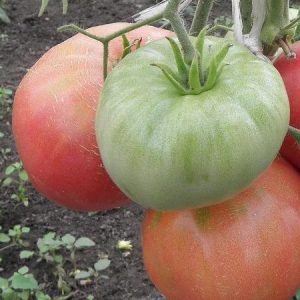 One of the main features of the variety is the large-fruited tomatoes. The average weight of one tomato is 650 g.
One of the main features of the variety is the large-fruited tomatoes. The average weight of one tomato is 650 g.
Subject to agrotechnical rules (with timely fertilization and abundant watering when growing tomatoes in a greenhouse), the fruits gain weight up to 800 g.
The largest tomatoes form on the lower shoots. Tomatoes that ripen first tend to be larger than later ones.
The shape of the fruit is round, slightly elongated. The surface is smooth, but in the area of the peduncle there is a weakly pronounced ribbing.
Ripe vegetables are dark red or deep pink. The shell of tomatoes is not thick, but dense, so that the fruits do not crack. The pulp is juicy and fleshy, the wateriness is moderate. The acidity and sugar content of vegetables are combined and form a pleasant sweetish taste without pronounced sourness.
The first tomatoes ripen in 105-110 days from the moment of emergence. The yield largely depends on the region where the variety is grown. In addition, the frequency of watering and fertilization affects the amount of the crop.
An average of 4 kg of crop is harvested from one bush, but with good care and cultivation in greenhouse conditions, this figure increases to 6 kg per plant.
How to grow seedlings
Tomato King Bell is grown through seedlings. This takes about 50-60 days. First, the seeds are disinfected and germinated at home. Grown plants are transferred under a film shelter or directly into open ground.
Seed preparation
If the seeds are colored in an unusual color, then the grain does not need additional processing - they have already been disinfected and kept in a nutrient solution by the manufacturer. If the seeds are hand-picked or harvested from your own harvest, then before sowing the grain is disinfected as follows:
- to destroy the larvae and eggs of pests, the seed material is placed in hot water for 10-15 minutes;
- from possible fungi, mold and rot, the seeds are disinfected in a weak (1%) solution of potassium permanganate (the grains are kept in it for 20-30 minutes).
For accelerated germination and friendly germination, tomato seeds are soaked in a growth stimulator for 15-20 hours. To do this, use the following drugs:
- Energen;
- "Zircon";
- "Baikal-EM1".
The funds are sold in specialized stores. They are used strictly according to the instructions on the package.
Capacity and soil
Seedlings are grown in different containers:
- disposable cups;
- wooden or plastic boxes;
- special purchased containers with cells and a lid;
- peat cups or tablets;
- cut off milk bottles or cartons.
For seedlings, a light nutritious soil is required, which is purchased in a store or prepared independently by mixing turf soil, river sand and humus (1: 1: 1).
Important! Before use, the soil mixture is treated with a weak solution of potassium permanganate in order to prevent infection of seeds with pathogenic organisms.
Sowing
Sowing seeds for seedlings is carried out in March or April - it all depends on the climatic characteristics of a particular region.
The prepared container is filled with soil, then grooves are made in the soil no deeper than 1.5-2 cm and seeds are sown in them. Cover with a small layer of peat on top, spray from a spray bottle, cover with a film or transparent glass and place in a warm place with an air temperature of about +25 ° C.
Growing and care
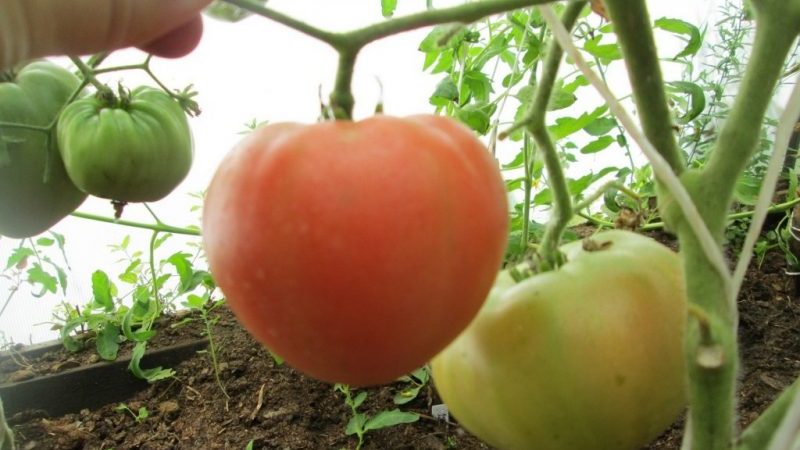
When shoots appear, the film is removed, and the container is sent to a well-lit place - for example, on a windowsill. The room temperature is lowered by several degrees. The optimum air temperature during the day is + 20 ... + 22 ° С, and at night + 10 ... + 15 ° С.
As it dries, the soil is moistened from the sprayer. For this, water is used settled and warm. Seedlings should be illuminated for 10-12 hours a day. With a short daylight hours, phytolamps are evenly installed over the bushes as additional lighting.
When the third true leaf appears on the seedlings, the plants dive into separate containers. But if the tomatoes were originally planted in different pots, the transplant is not carried out.
How to grow tomatoes
Seedlings are planted on a permanent place of growth not earlier than the end of May - beginning of June. Overcooling of the root system will reduce the yield, so the plants are transplanted into soil that is well heated by 8-10 cm.
The culture is demanding on lighting, so tomatoes are placed in a well-lit area away from buildings and trees. The garden bed has been prepared since autumn: it is cleared of weeds and residues of cultivated plants, then the soil is sprinkled with humus and dug up.
Landing
When the plants grow up to 30 cm, they are transplanted into open ground or a greenhouse. By this time, the bushes will have 6-7 leaves, they will bloom. Before planting, the bottom 3 leaves are removed from the plants to provide the tomatoes with good lighting.
Good precursors for tomatoes - cabbage, cucumbers, melons and gourds, root crops, green manure. Tomatoes are not grown for two consecutive years in the same place or after potatoes, eggplant and peppers.
Plants are planted in pre-prepared holes. The bushes are placed at a distance of 40 cm from each other, and 60 cm are left between the rows. In order for the plants to receive more sunlight, the culture is staggered.
Tomatoes are transferred to a permanent place along with a lump of earth. Sprinkle the roots with soil, which is lightly tamped. Then the plants are watered abundantly.
Care
With good care, the crop will not get sick and will yield a good harvest. The plant requires watering, fertilization and bush formation. After planting, the tomatoes are watered for 7-10 days. During this period, tomatoes adapt to a new place.
Moisturize the culture like this:
- until ovaries form, tomatoes are watered once a week (4 liters per bush);
- during the ripening of fruits, tomatoes are moistened twice a week (3 liters of water per plant).
If the Tsar Bell grows in a greenhouse, then the structure must be ventilated after watering to prevent high humidity and the occurrence of fungal diseases.
Culture watered with standing water or rainwater at room temperature. The development of plants will slow down from exposure to cold.
Tomatoes are fertilized several times a season. At the beginning of the growing season, plants are fed with nitrogen. In the future, to strengthen the root system and improve the taste of the fruit, the bushes are fertilized with potassium and phosphorus.
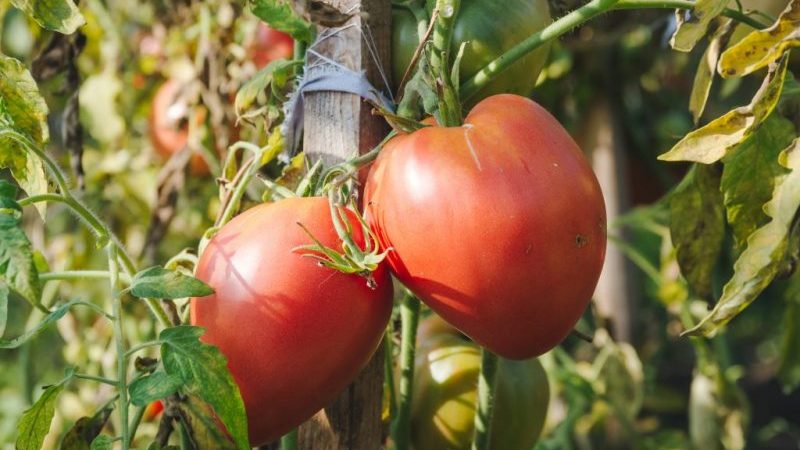
Tomatoes are fed according to the following scheme:
- 14 days after planting the plants in a permanent place, the culture is fertilized with a liquid mullein diluted with water in a ratio of 1:15;
- two weeks later, the tomatoes are fed with a solution of superphosphate and potassium salt (25 g of each agent per bucket of water);
- the next fertilization is carried out during the ripening of the fruits with a solution of potassium humate (1 tbsp. l. per 10 l of water).
Wood ash is a good substitute for mineral fertilizing. It is buried in the ground or added to water for irrigation.
The variety is formed into 1-2 stems. Stepsonsthat grow from the leaf sinus are removed. The first pinching is performed after transplanting plants into open ground or a greenhouse. Once a week, the lateral processes of the plants are broken off, leaving hemp up to 3 cm. During the period of fruit ripening, the lower leaves are removed from the plants. So the bushes will be better ventilated, and with growth in the greenhouse, the moisture level will decrease.
In order for oxygen to penetrate the root system, the soil around the plants is loosened to a depth of 5 cm, in the row spacing - 10 cm. The event is carried out 12-24 hours after watering. Together with loosening, weeds are removed so that it does not take away nutrients from the tomatoes. After aeration, the soil is mulched with compost. This will provide the plants with additional nutrition and help keep moisture in the soil longer in hot weather.
Features of cultivation and possible difficulties
Agricultural technology of the Tsar Bell variety is no different from the cultivation of other tomatoes. To obtain a bountiful harvest, plants are provided with timely watering and regular fertilizers.
Diseases and pests
The variety has a strong immunity to most nightshade diseases. Tomato Tsar Bell has good resistance to fungi and diseases such as:
- verticillosis;
- fusarium;
- late blight.
Disease resistance of tomato is high, but for confidence experienced vegetable growers take preventive measures. To reduce the risk of plant disease, the soil is disinfected with a hot solution of potassium permanganate.
After transplanting tomatoes to a permanent place, the garden bed is sprayed with any fungicide, for example:
- "Quadris";
- "Acrobat";
- Ridomil;
- Agat 25K;
- "Maxim".
The tomato has an average resistance to pests. Most often, the culture is affected by insects such as whitefly, wireworm, aphids.
To scare away insects, peat and humus are introduced into the soil. In order not to breed pests, weeds are regularly removed. The soil is treated with a light soapy solution - this will help get rid of aphids. Wood ash or tobacco dust is used against slugs. Folk remedies are replaced with insecticides, for example, "Aktellik", "Confidor", "Karate" or "Fitoverm".
The nuances of growing in open ground and in a greenhouse
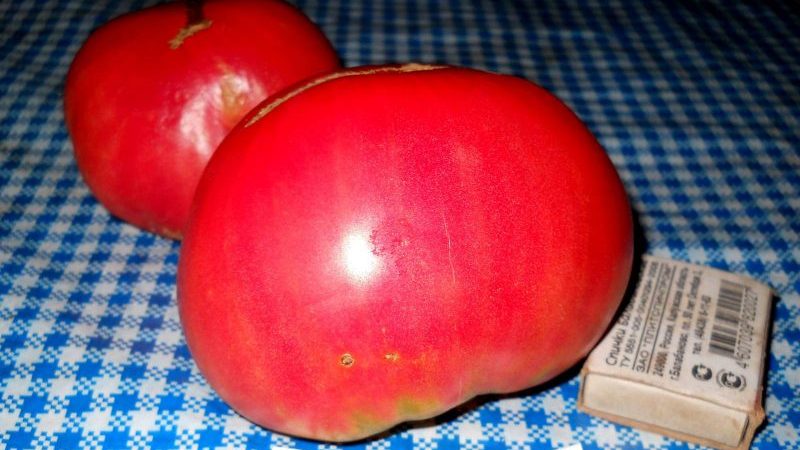
For the entire growing season, about three hilling is carried out, especially if the root system has eroded during watering, as well as as the lower leaves grow and break off. When the first flowers or fruits appear, the plants are tied to a support so that the main stem does not break from the weight of large fruits.
Harvesting and application of the crop
The fruits are harvested approximately 3.5 months after sowing. Tomatoes are often picked immature, as they ripen well indoors at room temperature. Thanks to their dense skin, tomatoes can be stored in proper conditions for several months without losing their external and taste characteristics.
Fresh salads are prepared from the fruits of this variety.Tomatoes are also great for making juice, sauce and ketchup. Because tomatoes are large, they are not suitable for whole fruit canning.
Important! The Tsar Kolokol variety is recommended for baby and diet food, as the fruits contain a large amount of beta-carotene.
Advantages and disadvantages of the variety
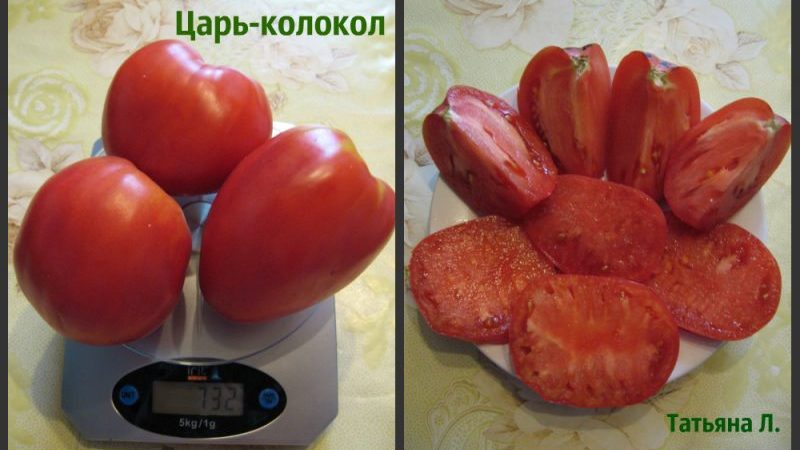
Vegetable growers appreciate the Tsar Bell tomato for such advantages:
- high level of productivity;
- culture resistance to disease;
- high germination of seeds;
- plant resistance to lower temperatures;
- presentation of fruits;
- early maturity of the variety;
- excellent taste;
- fruit crack resistance;
- transportability of vegetables.
The variety has few disadvantages:
- the need for plant formation and garter;
- high demand of the variety for fertilization, since large fruits require a large amount of nutrients;
- tomatoes are not suitable for whole fruit canning.
Farmers reviews
The Tsar Bell is unpretentious in maintenance, except for the need for regular fertilization to increase yields. The variety received high marks, and the high transportability of the fruits makes them suitable for growing for sale.
Vladimir, Krasnodar: “Last year Tsar Kolokol tried to grow tomatoes for the first time. There were no difficulties. The tomatoes grew large, as in the photo of the package with seeds. The vegetables taste sweet, without much sourness. To obtain a bountiful harvest of large-fruited tomatoes, the crop was grown in a greenhouse. I fertilized the plants three times a season and watered well. I was pleased with the harvest. One tomato weighed about 750 g. The wife made a delicious juice from these tomatoes. For conservation, the Tsar Bell is not at all suitable. In general, the family liked the variety. Next time I will grow it again. "
Ivan, Kursk: “Once I saw large-fruited tomatoes at my neighbor's. I also wanted to grow the same. He advised me to plant the Tsar Bell variety. I plant seedlings in open ground. The culture was practically not sick. I fed tomatoes 3 times. Watered the plants regularly. What I especially liked was the early maturity of the variety. The vegetables, although large, do not crack. The tomatoes are delicious and meaty. I liked the tsar bell, I advise everyone. "
Conclusion
Tomato Tsar Bell is successfully cultivated both in the greenhouse and in the open field. The cultivation of this variety does not require much effort. Tomatoes ripen in a short time, give a high yield and delight with their taste. The crop is resistant to most diseases, making it easy to grow these vegetables.